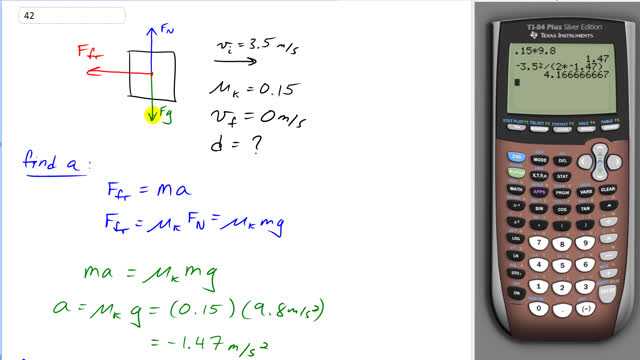
A box is given a push so that it slides across the floor. How far will it go, given that the coefficient of kinetic friction is 0.15 and the push imparts an initial speed of 3.5 m/s?

In order to watch this solution you need to have a subscription.
This is Giancoli Answers with Mr. Dychko. This box is initially moving to the right at 3.5 meters per second, there's normal force due to the surface pushing upwards and there's gravity down and friction is acting to the left to slow it down. And the question is, How far will it go before it finally stops? So, it is accelerating in the horizontal direction and, I mean, you know, negative acceleration in this case because acceleration is in the direction opposite to its initially positive velocity. And we have to figure out what that acceleration is. And then after we know that, we'll treat it as a kinematics question and figure out the displacement. So, the friction force equals mass times acceleration because friction force is the only force and so, it is the net force, and being the net force makes it equal to ma. And friction force we also know is the coefficient of kinetic friction times normal force. And the normal force is the only upwards force on this box. And so, it equals the total downwards force which is only mg. And so, the normal force is mg in this case. So, we can say, that ma being the friction force equals muK mg which is also the friction force. And having these equal to each other, we can divide both sides by m and solve for a. So, a is muK times g. So, that's 0.15 times 9.8 meters per second squared. I put in a negative sign here just because we know, and this algebra doesn't help us out very much with that, but we know this is directed to the left as shown in our picture. And then we'll just make our negative signs work out conveniently in this next part here round with the kinematics. So, we know the final velocity of this box will be zero because it's going to come to a stop and we'll subtract Vi squared from both sides. And we get 2d equals negative Vi squared and then divide both sides by 2 times acceleration. And we get the displacement then will be negative of 3.5 meters per second squared divided by 2 times negative 1.47 meters per second squared which will be 4.2 meters before it comes to a stop.
If the box is pushed, why is there no force in the positive direction on the x-axis? Also, why is there no net force?
Hi tnreifsnyder,
There is no force in the positive x-axis since the shove that made the box initially start moving has already finished. We begin the question at the moment when the shove is finished and the box has an initial speed of , and we want to know how far it will go. If there was no friction it would move forever (that's Newton's first law). However, there is in fact a net force along the x-axis: it's friction since that's the only x-axis force! We calculate how far the box will go given it's initial speed imparted by the shove, and the acceleration (or deceleration if you prefer that term) due to the friction force.
Hope that helps,
Mr. Dychko